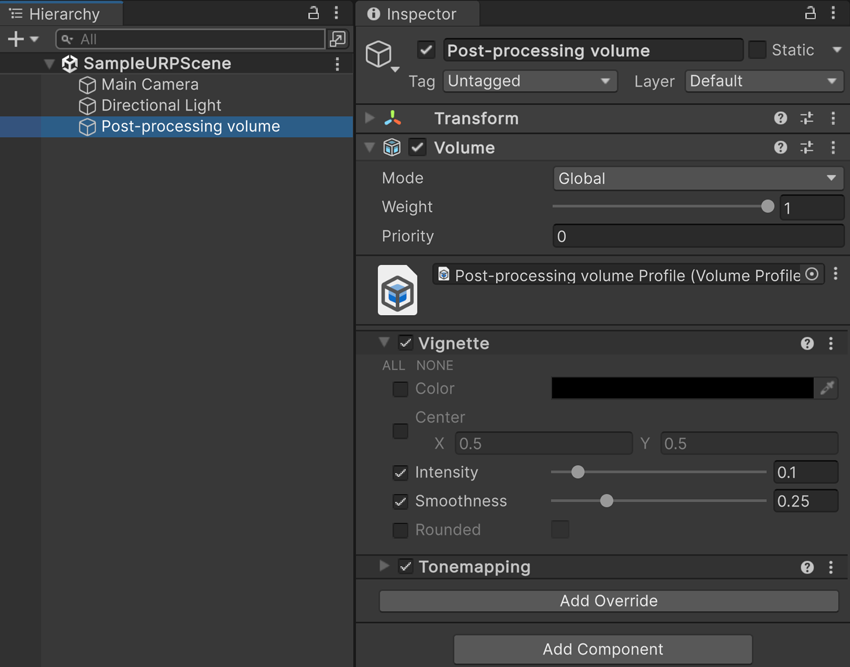Understand volumes in URP
The Universal Render PipelineA series of operations that take the contents of a Scene, and displays them on a screen. Unity lets you choose from pre-built render pipelines, or write your own. More info
See in Glossary (URP) uses volumes for post-processingA process that improves product visuals by applying filters and effects before the image appears on screen. You can use post-processing effects to simulate physical camera and film properties, for example Bloom and Depth of Field. More info post processing, postprocessing, postprocess
See in Glossary effects. Volumes can override or extend sceneA Scene contains the environments and menus of your game. Think of each unique Scene file as a unique level. In each Scene, you place your environments, obstacles, and decorations, essentially designing and building your game in pieces. More info
See in Glossary properties depending on the cameraA component which creates an image of a particular viewpoint in your scene. The output is either drawn to the screen or captured as a texture. More info
See in Glossary position relative to each volume.
You can create the following dedicated volume GameObjectsThe fundamental object in Unity scenes, which can represent characters, props, scenery, cameras, waypoints, and more. A GameObject’s functionality is defined by the Components attached to it. More info
See in Glossary:
- Global Volume
- Box Volume
- Sphere Volume
- Convex MeshThe main graphics primitive of Unity. Meshes make up a large part of your 3D worlds. Unity supports triangulated or Quadrangulated polygon meshes. Nurbs, Nurms, Subdiv surfaces must be converted to polygons. More info
See in Glossary Volume
You can also add a Volume component to any GameObject. A scene can contain multiple GameObjects with Volume components. You can add multiple Volume components to a GameObject.
At runtime, URP goes through all the enabled Volume components attached to active GameObjects in the scene, and determines each volume’s contribution to the final scene settings. URP uses the camera position and the Volume component properties to calculate the contribution. URP interpolates values from all volumes with a non-zero contribution to calculate the final property values.
Global and local volumes
There are two types of volume:
- Global volumes affect the camera everywhere in the scene.
- Local volumes affect the camera only if the camera is near the bounds of the colliderAn invisible shape that is used to handle physical collisions for an object. A collider doesn’t need to be exactly the same shape as the object’s mesh - a rough approximation is often more efficient and indistinguishable in gameplay. More info
See in Glossary on the parent GameObject.
Refer to Set up a volume for more information.
Volume Profiles and Volume Overrides
Each Volume component references a Volume Profile, which contains scene properties in one or more Volume Overrides. Each Volume Override controls different settings.
 A GameObject with a global volume. The Volume Profile has Vignette and TonemappingThe process of remapping HDR values of an image into a range suitable to be displayed on screen. More info
A GameObject with a global volume. The Volume Profile has Vignette and TonemappingThe process of remapping HDR values of an image into a range suitable to be displayed on screen. More info
See in Glossary Volume Overrides.
Refer to the following for more information:
Default volumes
All URP scenes have two default global volumes:
- The Default Volume for your whole project, which uses the Volume Profile set in Project Settings > Graphics > URP > Default Volume Profile.
- The global volume for the active quality level, which uses the Volume Profile set in the active URP Asset > Volumes > Volume Profile.
URP evaluates the default volumes only when you first load a scene or when you change the quality level, instead of every frame. If you use only the default volumes in a scene, URP has less work to do at runtime.
URP sets the default volumes to the lowest priority, so any volume you add to a scene overrides them.
Refer to the following for more information: